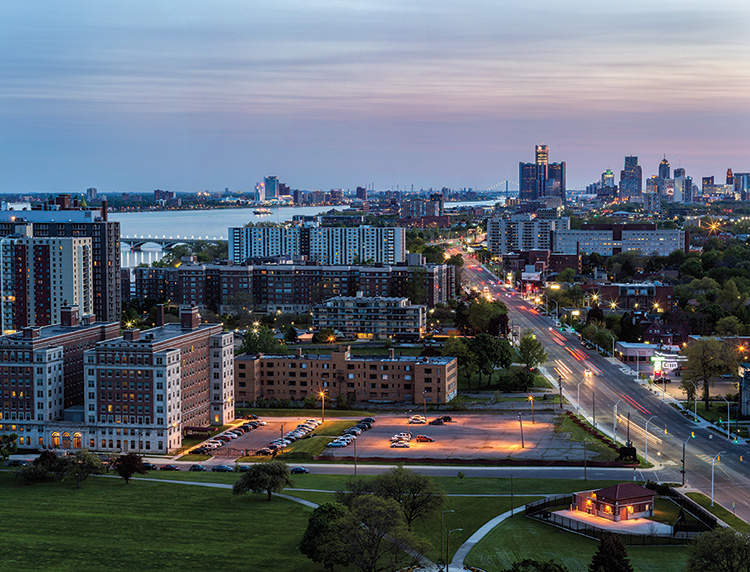Detroit is known for many things â manufacturing, Motown Records, and architecture to name a few. But the geography isnât much to write home about. The monotonous, flat landscape offers little in the way of views.
Thank goodness, then, for the Detroit River. The 1- to 2-mile-wide strait connecting Lake St. Clair and Lake Erie and separating the U.S. and Canada is by far the cityâs most prominent natural feature.

For millennia before the first European settlers arrived in Detroit, the strait was both sacred and of immense practical value to native people, who used the waterway to travel and conduct trade.
In 1701, when Antoine Laumet de La Mothe, Sieur de Cadillac, landed on the banks of what would come to be known as Detroit, the colonizer quickly grasped the value of riverfront real estate. Following French custom, Cadillac divided claims into âribbon farmsâââ¬ââââ¬âeach about 250 feet wide and 3 miles long âââ¬âthat all featured river frontage, ensuring all landowners in Detroit equitable access to the waterway for which the city is named.
More than 300 years later, as housing prices in downtown and Midtown skyrocket (according to a recent story in the Detroit Free Press, the median sale price of homes in Midtown has nearly doubled since 2013), the question on the minds of those concerned with city real estate is, âWhereâs next?â
The east riverfront is a natural starting point, as it features some of the most desirable real estate in the city and a variety of housing options â high-rise apartments and condos, waterfront manses, and canal-fronting home â all with stunning views of the cityâs greatest asset, the Detroit River.
The Jeffersonian apartments and the homes of the Joseph Berry Subdivision, which are located near each other, are great examples of the diversity of options for riverfront living in Detroit.
âBackyard in the Skyâ Alexander Brooks has lived in The Jeffersonian for nearly 30 years. His balcony overlooksÌýErmaÌýHenderson Marina and the downtown skyline.
Alexander Brooks has lived in The Jeffersonian for nearly 30 years. His balcony overlooksÌýErmaÌýHenderson Marina and the downtown skyline.
The Roaring â20s, when the rise of Art Deco skyscrapers paralleled the rise of the automotive industry, may have been Detroitâs architectural heyday. But the midcentury period was another high point, leaving behind stellar works like One Woodward Avenue and the McGregor Memorial Conference Center, designed by Minoru Yamasaki, who is best known for the World Trade Center and is one of Detroitâs most famous architects (second only, perhaps, to Albert Kahn). And of course there are the towers, townhomes, shopping center, and school of Lafayette Park, all designed by German-born modern master Ludwig Mies van der Rohe.
But less celebrated is The Jeffersonian, a 30-story, 410-unit midcentury masterpiece towering over the western edge of the Joseph Berry Subdivision along Detroitâs east riverfront.
Designed by Detroit firm Giffels & Rossetti (the original architects of Cobo Hall) and built in 1965, The Jeffersonian was constructed so lavishly that it bankrupted its developer, Arthur Fleischman. Still, he succeeded in his goal of building what was then the premier riverfront high-rise in the city.
The towering block of a building features views of cityscapes that are uniquely Detroit â the downtown skyline, blocks of the near east side that are lush with greenery and sparse of houses, Chryslerâs sprawling Jefferson North assembly plant, Waterworks Park, and the tidy Berry sub immediately below.
And then thereâs the water. The Jeffersonian features floor-to-ceiling windows with stunning views.
The Jeffersonian features floor-to-ceiling windows with stunning views.
Jeffersonian apartments look out on the Detroit River and Lake St. Clair, Belle Isle, a pair of marinas, and Windsor, Ontario. No unit in The Jeffersonian is deprived of a stunning view, each featuring floor-to-ceiling windows and an individual balcony (corner units have two).
âEveryone has a backyard in the sky, I like to say,â says Beverly Silk, whose family business, Saperstein Associates Enterprise, has owned and managed The Jeffersonian for 50 years. Sheâs referring to the fact that residents all tend to customize their balconies with everything from hanging plants and beach loungers to putting greens and workout equipment.
They tend to customize the insides, too. âWe encourage our residents to make their apartments their own,â Silk says. âIt gets them to stay.â
And stay they do. According to Mary Harrington, property manager of The Jeffersonian, who herself has lived in the building for over 15 years, the average Jeffersonian residentâs tenure is about a decade. âWe have some residents who have been here over 40 years,â she says.
Alexander Brooks, 57, is one of the longer-tenured residents of The Jeffersonian, having called the building home for nearly 30 years.
He immediately began customizing his current fifth-floor unit in August 2014 when he moved in from a different unit he shared with his brother for several decades. The Berry Subdivision boasts large Colonials and Tudors from the 1910s and â20s, plus a few modern McMansions that were built in the 1990s.
The Berry Subdivision boasts large Colonials and Tudors from the 1910s and â20s, plus a few modern McMansions that were built in the 1990s.
âI was shown one of the other units and I was kind of inspired to put this one together,â he says. Brooksâ apartment features Asian-inspired décor, zebra-striped accents, and a variety of custom furniture pieces. His balcony, which has views of Erma Henderson Marina and the downtown skyline, features workout equipment. âItâs contemporary and a little funky â a carefree type of style. It fits my personality,â Brooks says.
The layouts of The Jeffersonianâs apartments lend themselves to customization. There are four floor plans, from one- to four-bedrooms, each featuring a bathroom per bedroom and multiple walk-in closets. Corner units feature wrap-around balconies.
In addition to the units themselves, the buildingâs amenities, which include a heated Olympic-size swimming pool, tennis court, neighboring Erma Henderson Park and Marina, and a 24-hour doorman, keep residents happy.
âI like the security and the neighbors,â Brooks says. âThe upkeep is good and the management responds to maintenance issues.â
But the best thing about The Jeffersonian might be the relative affordability of its units. Depending on floor plan and view, rents range from $710 to about $2,000 per month, quite a bargain when you look at what some non-waterfront apartments are going for in downtown and Midtown. Leases are made over one-year terms, and occupancy tends to be at or near 92 percent.
Family Colony
Just east of The Jeffersonian and tucked below Jefferson Avenue and extending to the Detroit River, the Joseph Berry Subdivision is a small neighborhood consisting of just four streets and fewer than 90 homes, but the beauty of its residences â and the influence of its residents â are outsized.
Large Colonials and Tudors from the 1910s and â20s (and even a handful of McMansions from the 1990s) line the neighborhoodâs streets. Every Detroit mayor since Jerome Cavanagh (with the exception of Ken Cockrel Jr., who served just shy of eight months in office after embattled former Mayor Kwame Kilpatrick resigned) has called the Manoogian Mansion, located at 9240 Dwight St., home during their tenures as mayor. The 1928 Spanish Colonial has served as the official residence of the mayor of Detroit since it was donated to the city in 1966.
Diane Linn has lived with her husband, Thom, in their home on Dwight Street since 1983. The house â a 10-room, 5,200-square-foot Georgian Colonial â was built in 1920 by the Webbers, a prominent Detroit family who ran a lumber company and established something of a family colony along Dwight Street, building five houses for members of their immediate and extended family.
âAll of the families would gather at our house for Sunday dinner,â says Diane. The houses were also connected literally, all heated by an external furnace that delivered steam via underground pipes, though that system has since been modernized.
Since the Webbers moved out, the house had seen a slew of owners. A prominent local insurance agent who was friends with Muhammad Ali owned the house before the Linns, who have a photo of The Greatest playing pool in one of the rooms upstairs.
Later, an off-campus Wayne State University fraternity owned the house and did quite a bit of damage to the moldings in what likely must have been some epic keggers.
âWe did a tremendous amount of woodwork restoration,â says Diane. âWe stripped it all down to bare oak. The kitchenâs been totally redone. Right now weâre having column restoration done.
âThe winds off the river are really strong, and they take a toll on the details.â
The Linnsâ Georgian Colonial, which is a common architectural style in the South, was designed with natural cooling features, including front and rear doors on both levels to allow for the circulation of air coming off the river.
âThe breezes are wonderful,â says Diane. âItâs great because it tends to be humid by the water.â
 Diane Linn and her husband, Thom, have lived in their Georgian Colonial since 1983. The backyard offers a view of the Detroit River and Belle Isle.
Diane Linn and her husband, Thom, have lived in their Georgian Colonial since 1983. The backyard offers a view of the Detroit River and Belle Isle.
Of course, if it gets too hot in the summer months, just being in the beautiful backyard of the house is a great way to cool down.
The 300-foot-deep yard stretches from the back porch of the house directly to the riverfront, is dotted with shady maples and willows and features a view of the eastern half of Belle Isle.
âWe see a lot of the Diamond Jack tour boats, and we hear them talking on the loudspeaker talking about the history of the houses and the mayorâs mansion,â says Diane. âWe also see a lot of dinner cruises from Lake St. Clair and pleasure boats.
âEarly in morning, we hear the rowers from the Detroit Boat Club.â
During Prohibition, itâs possible that the houseâs riverfront location had other advantages beyond beautiful views and temperate breezes.
âWhen we moved in,â says Diane, âwe decided to clean up the basement. There was this huge, long table that was supported by old beer kegs. When we lifted the tabletop off, the beer barrels were filled with wine bottles. We also found some old signs that said things like âKielbasa dinner, $0.50.â â
Today, homes like the Linnsâ are still good for a party. Neighbors wander around between backyards, which have no fences, during annual events such as hydroplane races and fireworks (the venerable boat race â now dubbed the UAW-GM Spirit of Detroit HydroFest celebrates its 100th anniversary in August).
Two of the four Linn children have been married in the backyard, and for years the Linns have hosted an annual ticketed soiree during the hydroplane races, with the proceeds going to a charity of their choosing. The Community Chorus of Detroit, of which Diane is the executive director and president of the board, has often been the beneficiary.
âYears ago, when the races were really huge in Detroit sporting events, weâd have 400 people here for lunch,â says Diane. âIt was quite an event.â
 Surprisingly affordable homes in the Harbor andÌýKlenkÌýIslands in the Jefferson-Chalmers neighborhood are situated on canals that offer access to Lake St. Clair and the Detroit River.
Surprisingly affordable homes in the Harbor andÌýKlenkÌýIslands in the Jefferson-Chalmers neighborhood are situated on canals that offer access to Lake St. Clair and the Detroit River.
The parties havenât been limited to the yard, either. One Christmas, a 16-voice choir with orchestra did a performance of Handelâs Messiah in period costume â right in the Linnsâ living room, which is adjacent to the houseâs main hall where the Linns often install a 20-foot Christmas tree that has to be decorated on ladders.
These houses in the Berry Sub, particularly those along the riverfront, rarely go on the market. A non-waterfront, 5,200-square-foot Tudor described as a ârenovation opportunityâ sold last year for $220,000. The Linnsâ newest neighbor, Kid Rock, moved in two years ago to a house on the west end of Dwight Street. (Take a peek, but his is blurred out on Google street view.)
âWhen we moved in back in the â80s, we chose the neighborhood not only for the architectural beauty, but because it was a racially diverse neighborhood,â says Diane. âBeing a part of the life of the city was really an important consideration. Over the years, our neighborhood has remained diverse. Itâs the kind of place where people take casseroles to each other, walk their dogs, ride their bikes.
âItâs the kind of place every neighborhood in America should be.â
More Riverfront Options
With limited availability of units and houses in both The Jeffersonian and Berry Subdivision, there are plenty of other places along the east riverfront that offer charming views and unique amenities. Here are a few places to keep your eye on:
Alden Towers
The price is right at Alden Towers, a 380-unit apartment complex on East Jefferson Avenue at the foot of Van Dyke Avenue. Units range from 300-square-foot studios to 1,300-square-foot three bedrooms.
While some of the historical charm of individual apartmentsâ interiors has been replaced with modern drywall and many other practical features â including brand-new appliances â you get a lot of bang for your buck at Alden.
Additionally, you are right up the road from Belle Isle, Gabriel Richard Park, and the east RiverWalk, as well as walking distance from the burgeoning retail and restaurant scene of West Village.

´³±ð´Ú´Ú±ð°ù²õ´Ç²Ô-°ä³ó²¹±ô³¾±ð°ù²õÌýThe varied homes on Harbor and Klenk Islands in the Jefferson-Chalmers neighborhood just west of Grosse Pointe Park are some of the cityâs best-kept secrets. Situated on canals that allow homeowners immediate access to Lake St. Clair and the Detroit River, itâs amazing that prices are relatively affordable at $100,000-$200,000 per house. Amenities in Grosse Pointe Park and a burgeoning retail scene on East Jefferson, which features Hello Records and Coffee & (___), are just a short bike ride or walk away.
Coming Soon: Orleans LandingÌýand Beyond
An entirely new neighborhood is being constructed in the warehouse district east of downtown. With river views access to the RiverWalk and Dequindre Cut, and proximity to downtown and Eastern Market, apartments in this $65 million, 270-unit development are expected to fetch rents between $1,500 and $2,000 per month. And stay tuned for even more. The city recently tapped a team to develop a comprehensive plan for the East Riverfront District.
Berry, Berry, Berry Fine Houses
Think of Detroitâs historic Berry Subdivision as itâs own little three-street-long, one-block-wide oasis. The Manoogian Mansion rests along the river here, and is often the star of the show. And thereâs the Linn home on Dwight StreetÌýfeatured in our main story. But there are plenty of other noteworthy structures. Take the Stanton house for example. After all, it was there first.

The then-named âPark Viewâ development began before the turn of the century. In 1898, architect Louis Kamper built a structure for Detroit clothing manufacturer Marvin Stanton. The home â with its towers and turrets â gained the nickname, âThe Castle.â The Manoogian is a spring chicken in comparison. Built in 1928, it became the mayorâs place when the Manoogians (founders of Masco) donated it to the city in 1966. But thatâs another story.
âThe Castleâ used to be run as a banquet hall by Sean Shannon. From 1987 on, he hosted intimate fundraisers, weddings, and more. Shannon moved to Southfield and started Tapestry.
And just like at The Castle, the banquet hall/catering business has chef Daniel Carroll in the kitchen (who had previous stints at The Golden Mushroom and Sparky Herbertâs). While Tapestry thrives in several locations, ânone of them match The Castle,â Shannon says. But he adds that âitâs nice to have a life. I was there 24/7.â
The Castleâs next-door neighbor is nicknamed âThe White House.â

The Castle and The White House sit side by side on Parkview, with their backyards snugging up to the Stanton Canal. The White House,Ìýtoo, has a storied past. Built in 1905, it was run as a bed and breakfastÌýby Shannonâs late mother, Mary Jean Shannon, accompanied by her faithful dog, Ernie, in the early toÌýmid-â90s.
So hereâs our tale of two houses. The Castle is undergoing an extensive renovation (think along the lines of Nicole Curtisâ Ransom-Gillis house in Brush Park). Meanwhile, at press time, The White House was waiting for adoption ⦠maybe. It was listed for a mere $240,000 â and a deal was pending. But fair warning. A crew member renovating The Castle next door estimated that the outside alone would take around $100,000 to spruce up.
In fact, another former owner, Michele Bezue (who owns the Detroit Marshmallow Company) says that before she sold the house during the 2007 recession (âToo much work for not enough money,â), she got an estimate of $28,000 for historically accurate, energy-efficient windows in the front of the house alone. Things get a bit murky here. ApparentlyÌýit was later owned by a mysterious âpastorâ who up and abandoned it.
Whoever ends up in The White House will get a six-bedroom, three full- and two-half bath place. There are porches off four of the rooms with views of the canal. Oh, and that house next door is certainly nice, too. As is that little Manoogian place down the road.
|
| Ìý |
|








